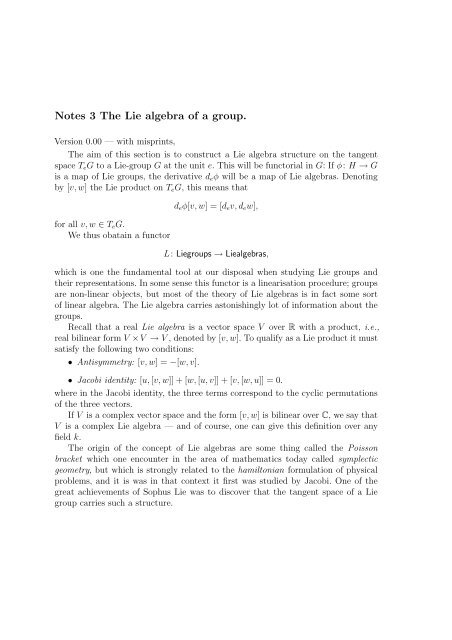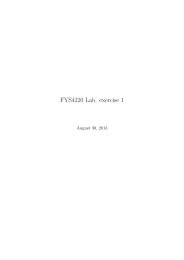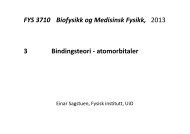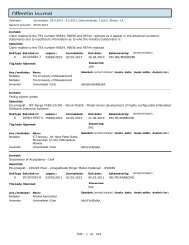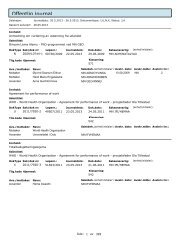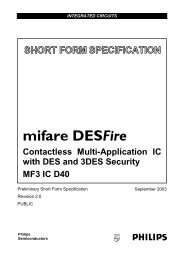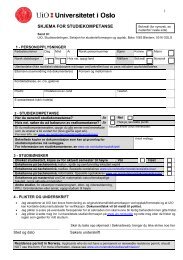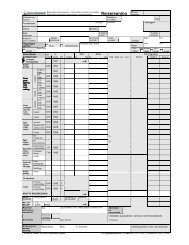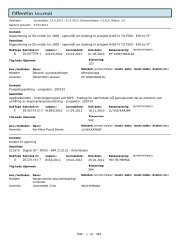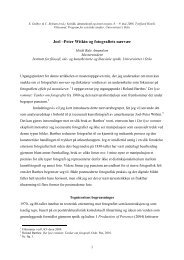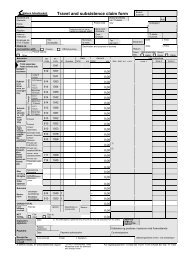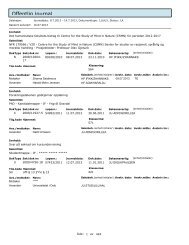Notes 3 The Lie algebra of a group.
Notes 3 The Lie algebra of a group.
Notes 3 The Lie algebra of a group.
Create successful ePaper yourself
Turn your PDF publications into a flip-book with our unique Google optimized e-Paper software.
<strong>Notes</strong> 3 <strong>The</strong> <strong>Lie</strong> <strong>algebra</strong> <strong>of</strong> a <strong>group</strong>.<br />
Version 0.00 — with misprints,<br />
<strong>The</strong> aim <strong>of</strong> this section is to construct a <strong>Lie</strong> <strong>algebra</strong> structure on the tangent<br />
space T e G to a <strong>Lie</strong>-<strong>group</strong> G at the unit e. This will be functorial in G: Ifφ: H → G<br />
is a map <strong>of</strong> <strong>Lie</strong> <strong>group</strong>s, the derivative d e φ will be a map <strong>of</strong> <strong>Lie</strong> <strong>algebra</strong>s. Denoting<br />
by [v, w] the <strong>Lie</strong> product on T e G, this means that<br />
for all v, w ∈ T e G.<br />
We thus obatain a functor<br />
d e φ[v, w] =[d e v, d e w],<br />
L: <strong>Lie</strong><strong>group</strong>s → <strong>Lie</strong><strong>algebra</strong>s,<br />
which is one the fundamental tool at our disposal when studying <strong>Lie</strong> <strong>group</strong>s and<br />
their representations. In some sense this functor is a linearisation procedure; <strong>group</strong>s<br />
are non-linear objects, but most <strong>of</strong> the theory <strong>of</strong> <strong>Lie</strong> <strong>algebra</strong>s is in fact some sort<br />
<strong>of</strong> linear <strong>algebra</strong>. <strong>The</strong> <strong>Lie</strong> <strong>algebra</strong> carries astonishingly lot <strong>of</strong> information about the<br />
<strong>group</strong>s.<br />
Recall that a real <strong>Lie</strong> <strong>algebra</strong> is a vector space V over R with a product, i.e.,<br />
real bilinear form V ×V → V , denoted by [v, w]. To qualify as a <strong>Lie</strong> product it must<br />
satisfy the following two conditions:<br />
• Antisymmetry: [v, w] =−[w, v].<br />
• Jacobi identity: [u, [v, w]] + [w, [u, v]] + [v, [w, u]] = 0.<br />
where in the Jacobi identity, the three terms correspond to the cyclic permutations<br />
<strong>of</strong> the three vectors.<br />
If V is a complex vector space and the form [v, w] is bilinear over C, we say that<br />
V is a complex <strong>Lie</strong> <strong>algebra</strong> — and <strong>of</strong> course, one can give this definition over any<br />
field k.<br />
<strong>The</strong> origin <strong>of</strong> the concept <strong>of</strong> <strong>Lie</strong> <strong>algebra</strong>s are some thing called the Poisson<br />
bracket which one encounter in the area <strong>of</strong> mathematics today called symplectic<br />
geometry, but which is strongly related to the hamiltonian formulation <strong>of</strong> physical<br />
problems, and it is was in that context it first was studied by Jacobi. One <strong>of</strong> the<br />
great achievements <strong>of</strong> Sophus <strong>Lie</strong> was to discover that the tangent space <strong>of</strong> a <strong>Lie</strong><br />
<strong>group</strong> carries such a structure.
<strong>Notes</strong> 3: <strong>The</strong> <strong>Lie</strong> <strong>algebra</strong> <strong>of</strong> a <strong>group</strong> MAT4270 — Høst 2012<br />
Exampel —gl(n, K) <strong>The</strong> arche-example <strong>of</strong> a <strong>Lie</strong> <strong>algebra</strong>, is the vector space M n (R)<br />
<strong>of</strong> n × n- matrices (or the space M n (C) if you want a complex <strong>Lie</strong> <strong>algebra</strong>) with the<br />
commutator as <strong>Lie</strong> product, i.e., [x, y] =xy − yx.<br />
Example — sl(n, K). Recall that the tangent space to Sl(n, K ) is the space <strong>of</strong><br />
traceless matrices in M n (K). As tr xy =tryx it follows immediatly that [x, y] is<br />
traceless if both x and y are. Hence sl(n, K) is closed under the commutator product,<br />
and thus is a <strong>Lie</strong> <strong>algebra</strong>.<br />
Example — so(n, K). <strong>The</strong> tangent space <strong>of</strong> SO(n, K) is the space <strong>of</strong> traceless<br />
matrices x ∈ M n (K) with x t = −x. An easy computation shows that so(n, K) also<br />
is closed under the bracket:<br />
so so(n, K) is a <strong>Lie</strong> <strong>algebra</strong>.<br />
(xy − yx) t = y t x t − x t y t = −(xy − yx), Gand<br />
Example — general case. <strong>The</strong> previous example generalises. If Q is any symetric<br />
matrix the set <strong>of</strong> elements a ∈ N n K satisfying<br />
a t Q + Qa =0<br />
is closed under the bracket product and it is a <strong>Lie</strong> <strong>algebra</strong>. Indeed:<br />
(ab − ba) t Q + Q(ab − ba) =b t (a t Q + Qa)b − a t (b t Q + Qb)a =0.<br />
It is not a big suprise that a <strong>Lie</strong> <strong>algebra</strong> homophism Φ: M → L is a linear map<br />
respecting the <strong>Lie</strong> product, i.e., Φ[v, w] = [Φv, Φw]. <strong>The</strong> usual <strong>algebra</strong>ic concepts <strong>of</strong><br />
sub<strong>algebra</strong> and ideal carriy over to <strong>Lie</strong> <strong>algebra</strong>s. A sub<strong>algebra</strong> is a vector subspace<br />
M⊆ L closed under the <strong>Lie</strong> product, that is [x, y] ∈ M whenever x, y ∈ M and an<br />
ideal is a sub vector space closed under the product with any element in L: Ifx ∈ L<br />
and y ∈ M, then [x, y] ∈ M. To be an ideal is a stronger requirement than to be a<br />
sub<strong>algebra</strong>, so any ideal is a sub<strong>algebra</strong>.<br />
A <strong>Lie</strong> <strong>algebra</strong> might very well have a trivial product, that is [x, y] = 0 for all x<br />
and y. Such an <strong>algebra</strong> is called abelian — a natural name if one think about the<br />
<strong>Lie</strong> product as a commutator. In fact, as the antisymmetry implies that [x, x] =0,<br />
any one dimensional <strong>Lie</strong> <strong>algebra</strong> is abelian.<br />
One also easily checks that there is unique <strong>Lie</strong> product on M ⊕ L such that the<br />
two projections are <strong>Lie</strong> <strong>algebra</strong> homorphisms, and that this product enjoys the usual<br />
universal property for a cartesian product.<br />
—2—
<strong>Notes</strong> 3: <strong>The</strong> <strong>Lie</strong> <strong>algebra</strong> <strong>of</strong> a <strong>group</strong> MAT4270 — Høst 2012<br />
Constructing the <strong>Lie</strong> <strong>algebra</strong><br />
<strong>The</strong>re are several ways <strong>of</strong> constructing the <strong>Lie</strong> product on the tangent space T e G.<br />
<strong>The</strong> classical one, which is close to what Sophus <strong>Lie</strong> did, is <strong>of</strong> global nature and<br />
involves smooth vector fields, i.e., smooth global sections <strong>of</strong> the tangent bundle.<br />
Such sections form, for any manifold, a <strong>Lie</strong> <strong>algebra</strong>. (A global tangent field is just a<br />
derivation 1 operating on global, smooth functions, and the commutator <strong>of</strong> two such<br />
derivations is anew a derivation 2 .)<br />
<strong>The</strong> space <strong>of</strong> all global tangent fields however is huge, far from being <strong>of</strong> finite<br />
dimension, like for G = R, where the global fields are <strong>of</strong> the form f(x)D x where f(x)<br />
is any smooth function. <strong>The</strong> clue is to couple the fields with the <strong>group</strong> structure,<br />
and use what is called left invariant vector fields. <strong>The</strong>y form a finite dimensional<br />
vector space, which in fact is in one-one correspondence with the tangent space at<br />
the unity. We shall come to back to that.<br />
<strong>The</strong>re is also a slighly delicate point concerning the functoriality. <strong>The</strong> tangent<br />
bundle is perfectly functorial. Any smooth map f : X → Y between manifolds gives<br />
rise to a commutative diagram<br />
TX<br />
df<br />
TY<br />
X<br />
f<br />
Y.<br />
If D is a section <strong>of</strong> TX, the best thing we get is the diagram<br />
D<br />
TX<br />
df ◦D<br />
df<br />
TY<br />
f<br />
X Y,<br />
and there is in general no way to get a section <strong>of</strong> TY from this — there is no reason<br />
why df ◦D in general such be constant along the fibres <strong>of</strong> f. So the global derivations<br />
1 If A is any R-<strong>algebra</strong>, a derivation is an R-linear map D : A → A satisfying Leibnitz rule:<br />
D(ab) =aD(b)+D(a)b<br />
2 To check this is straight ahead, but somehow tedious: One gets twelve terms to mediate between,<br />
however, at the end <strong>of</strong> the day, the eight bad guys extirpate each other.<br />
—3—
<strong>Notes</strong> 3: <strong>The</strong> <strong>Lie</strong> <strong>algebra</strong> <strong>of</strong> a <strong>group</strong> MAT4270 — Høst 2012<br />
do not behave in a functorial way — that property <strong>of</strong> the <strong>Lie</strong>-<strong>algebra</strong>, comes from<br />
the functoriality <strong>of</strong> the tanget space at the unity.<br />
Neither do these methods explain the roots <strong>of</strong> the <strong>Lie</strong>-product. It is completly<br />
a local construction, and indeed it is very simple and natural. <strong>The</strong> existence <strong>of</strong> the<br />
product comes from the <strong>group</strong> having av neutral element, and the Jacobi identitity<br />
is a direct consequence <strong>of</strong> the assositive law.<br />
I find it most natural to introduce the <strong>Lie</strong> product by a local analysis <strong>of</strong> the<br />
<strong>group</strong> law, even if this is against the spirit <strong>of</strong> Sophus <strong>Lie</strong>, and even if this violates<br />
the “ordre du jour ” <strong>of</strong> modern mathematics (which I normal embrace warmly):<br />
“Avoid using coordinates!”<br />
In the construction, there is no fancy business at all, just some calculations which<br />
could be done by a first year calculus student. <strong>The</strong> only thing used is the Taylor<br />
development to the third order and a symmetry argument using permutations <strong>of</strong><br />
three variables.<br />
We start by choosing a coordinate neighbourhood U round e with chart U⊆ T ,<br />
parametrisation p: U → U and coordinates ξ : U → U. We assume that the neutral<br />
element e corresponds to the origin 0 in T. Thus the derivative d 0 p <strong>of</strong> p at 0, is an<br />
isomorphism <strong>of</strong> the vector space T with T e G with inverse d e ξ,<br />
We transport (the restriction <strong>of</strong>) the multiplication map to a C ∞ -map µ: U ×<br />
U → U. Strictly speaking, we get µ defined on a possibly smaller open set U 0 ⊆ U,<br />
but we really work with “the germ <strong>of</strong> the <strong>group</strong>” or what people call a “local <strong>group</strong>”,<br />
which entail that we can shrink the neigbourhood U whenever we need to, or more<br />
precisely, we work with the Taylor expansion <strong>of</strong> µ up to a fixed order; e.g., order<br />
three:<br />
Lemma 1 <strong>The</strong>re are forms β and γ <strong>of</strong> degree 2 and 3 on T such that: µ(x 1 ,x 2 )=<br />
x 1 + x 2 + β(x 1 ,x 2 )+γ(x 1 ,x 2 )+o(4)<br />
Pro<strong>of</strong>: As said, this is just the ordinary Taylor-development <strong>of</strong> µ to the order<br />
three — the notation o(4) 3 indicates a term whose only relevant property is that its<br />
degree is higher than three — the only thing to remark is that µ(0,x 2 )=x 2 and<br />
µ(x 1 , 0) = x 1 since eg = g and ge = g for all g. Hence the absence <strong>of</strong> coefficients in<br />
the linear term. <strong>The</strong> rest <strong>of</strong> the statement is just giving names to the quadratic and<br />
the cubic terms.<br />
❏<br />
Now <strong>of</strong> course the form β depends on the choice <strong>of</strong> coordinates, but the miracle<br />
is that the difference β(x 1 ,x 2 ) − β(x 2 ,x 1 ) does not! And this difference is the <strong>Lie</strong><br />
3 <strong>The</strong> correct but cumbersome notation is the standard big O notation O((x 1 ,x 2 ) 4 )<br />
—4—
<strong>Notes</strong> 3: <strong>The</strong> <strong>Lie</strong> <strong>algebra</strong> <strong>of</strong> a <strong>group</strong> MAT4270 — Høst 2012<br />
product. We define<br />
[x 1 ,x 2 ]=β(x 1 ,x 2 ) − β(x 2 ,x 1 ). (✿)<br />
And this is an antisymmetric (obviously) quadratic form (since β is).<br />
Example — Gl(n, R). If G⊆ Gl(n, R), and x and y are two tangent vectors at I n —<br />
i.e., matrices in M n (R) lying in the tangent space T In G —- we get (I +x)(I +y) =<br />
I + x + y + 2 xy. Hence β(x, y) =xy and [x, y] =xy − yx.<br />
To be precise: <strong>The</strong> bracket we just defined with equation ✿, is defined on the<br />
tangent space T <strong>of</strong> the chart U. Foranytwovectorsv, w ∈ T e G, we may transport<br />
them to T , compute the bracket there and send the result back into T e G. In this<br />
way, we get a bracket on T e G by setting<br />
<strong>The</strong>orem 1 <strong>The</strong> quadratic form on T e G<br />
[v, w] =d 0 ξ −1 [d e ξv,d e ξw].<br />
[v, w] =d 0 ξ −1 [d e ξv,d e ξw]<br />
is independent <strong>of</strong> the choice <strong>of</strong> coordinates.<br />
In fact there is stronger statement, the form [x 1 ,x 2 ] is even functorial:<br />
<strong>The</strong>orem 2 If φ: U → V is a map <strong>of</strong> local <strong>Lie</strong> <strong>group</strong>s, then<br />
d 0 φ[x 1 ,x 2 ]=[d 0 φx 1 ,d 0 φx 2 ].<br />
Pro<strong>of</strong>: That φ is a map <strong>of</strong> local <strong>Lie</strong> <strong>group</strong>s means <strong>of</strong> course that<br />
φµ 1 (x 1 ,x 2 )=µ 2 (φx 1 ,φx 2 ). (❃)<br />
<strong>The</strong> Taylor development <strong>of</strong> φ to the second order has the form<br />
φ(x) =d 0 φx + α(x)+o(3),<br />
where α is a quadratic term. We compute, always up to terms <strong>of</strong> order three or more:<br />
µ 2 (φx 1 ,φx 2 )=dφx 1 + dφx 2 + α(x 1 )+α(x 2 )+β 2 (dφx 1 ,dφx 1 )+O(3).<br />
Continuing in the same manner, we get:<br />
φµ 1 (x 1 ,x 2 )=dφx 1 + dφx 2 + dφβ 1 (x 1 ,x 2 )+α(x 1 + x 2 )+O(3).<br />
—5—
<strong>Notes</strong> 3: <strong>The</strong> <strong>Lie</strong> <strong>algebra</strong> <strong>of</strong> a <strong>group</strong> MAT4270 — Høst 2012<br />
Using the identity ❃ we obtain from these the following identity between the second<br />
order terms:<br />
α(x 1 )+α(x 2 )+β 2 (dφx 1 ,dφx 1 )=dφβ 1 (x 1 ,x 2 )+α(x 1 + x 2 )<br />
As the terms α(x 1 )+α(x 2 ) and α(x 1 + x 2 ) are symetric in x 1 and x 2 , they disappear<br />
when we swich x 1 and x 2 and take differences. <strong>The</strong> theorem follows then. ❏<br />
<strong>The</strong>orem 1 follows from this: Given two coordinates systems ξ 1 and ξ 2 round e,<br />
which we may assume are defined on the same open set U , we get by using theorem<br />
2 and setting φ = ξ 2 ξ1 −1 :<br />
d 0 ξ 2 ξ −1<br />
1 [d e ξ 1 v, d e ξ 1 w]=[d e ξ 2 v, d e ξ 2 w]<br />
from which the theorem follows easily.<br />
So far so good, we have without to much effort — and without using technical<br />
tools more advanced than the Taylor development to the second order! — proved<br />
that there is an intrinsicly defined, functorial antisymmetric product on the tangent<br />
space T e G! And in fact, we have only used the existence <strong>of</strong> a neutral element.<br />
What rests, is the Jacobi identity, which is a little more demanding. It comes<br />
from the assosiativity <strong>of</strong> the multiplication. <strong>The</strong> formulas get a little involved, as we<br />
have to use Taylor developments to the third order, and in the end <strong>of</strong> the calculations,<br />
we are left with and identity with a priori 36 terms. However, the symmetric <strong>group</strong><br />
on three letters is a perfect tool to make the final argument very simple (and as an<br />
additional bonus: A good illustration <strong>of</strong> how efficient <strong>group</strong>s can be!)<br />
We start with the following, which is what we get from the associativity:<br />
Lemma 2<br />
Pro<strong>of</strong>: We have<br />
β(β(x 1 ,x 2 ),x 3 )+γ(x 1 ,x 2 )+γ(x 1 + x 2 ,x 3 )=<br />
β(x 1 ,β(x 2 ,x 3 )) + γ(x 2 ,x 3 )+γ(x 1 ,x 2 + x 3 )<br />
µ(µ(x 1 ,x 2 ),x 3 )=x 1 + x 2 +β(x 1 ,x 2 )+γ(x 1 ,x 2 )+<br />
x 3 + β(x 1 + x 2 ,x 3 )+β(β(x 1 ,x 2 ),x 3 )+γ(x 1 + x 2 ,x 3 )+o(4).<br />
and<br />
µ(x 1 ,µ(x 2 ,x 3 )) = x 1 + x 2 + x 3 + β(x 1 ,x 2 + x 3 )+β(x 2 ,x 3 )+<br />
γ(x 2 ,x 3 )+β(x 1 ,β(x 2 ,x 3 )) + γ(x 1 ,x 2 + x 3 )+o(4).<br />
—6—
<strong>Notes</strong> 3: <strong>The</strong> <strong>Lie</strong> <strong>algebra</strong> <strong>of</strong> a <strong>group</strong> MAT4270 — Høst 2012<br />
Now, the left sides <strong>of</strong> these to equations are equal because µ is associative. We see<br />
that all terms <strong>of</strong> degree less than three cancels (again we use that β is bilinear), and<br />
we get the formula in the lemma.<br />
❏<br />
To finish the pro<strong>of</strong> <strong>of</strong> the Jacobi indentity, we shall atisymmetrise the equation<br />
in lemma 2. Recall that if f(x 1 ,x 2 ,x 3 ) is any function in three variables, the antisymmetrisation<br />
Θf is the alternating sum over all permutations <strong>of</strong> the variables.<br />
That is:<br />
Θf(x 1 ,x 2 ,x 3 )= σ∈S 3<br />
(σ)f(x σ(1) ,f σ(2) ,f σ(3) ),<br />
where (σ) denotes the sign <strong>of</strong> σ,i.e., (σ) =−1 if σ is a transposition and (σ) =1<br />
if σ is cyclic permutation. For any τ ∈ S 3 , it is clearly true Θf(x τ(1) ,x τ(2) ,x τ(3) )=<br />
(τ)Θf(x 1 ,x 2 ,x 3 ).<br />
Now we antisymmetrize the equaion in the lemma 2 above, and I claim that<br />
all the terms involving γ then cancel. Indeed, Θγ(x 1 ,x 2 )=Θγ(x 2 ,x 3 ) since the<br />
cyclic permutation 2 → 3 → 1 → 2 is even. Since γ(x 1 + x 2 ,x 3 ) is invariant under<br />
the odd permutation that interchanges 1 and 2, and γ(x 1 ,x 2 + x 3 ) under the one<br />
interchanging 2 and 3, it holds true that Θγ(x 1 + x 2 ,x 3 )=Θγ(x 1 ,x 2 + x 3 )=0.<br />
Hence<br />
Θβ(β(x 1 ,x 2 ),x 3 )=Θβ(x 1 ,β(x 2 ,x 3 )).<br />
In this equation there are twelve terms, six on either side, and we are going to <strong>group</strong><br />
them four by four by <strong>group</strong>ing together terms having the samme variable standing<br />
alone. We start with those having x 3 as a lone varaiable. On the left we have the<br />
difference (interchanging 1 and 2 is an odd permutation):<br />
β(β(x 1 ,x 2 ),x 3 ) − β(β(x 2 ,x 1 ),x 3 )=β([x 1 ,x 2 ],x 3 )<br />
where as on the right side, there is the difference<br />
β(x 3 ,β(x 1 ,x 2 )) − β(x 3 ,β(x 2 ,x 1 )) = β(x 3 , [x 1 ,x 2 ])<br />
moving the right side to the left, we get the term<br />
β([x 1 ,x 2 ],x 3 ) − β(x 3 , [x 1 ,x 2 ]) = [[x 1 ,x 2 ],x 3 ].<br />
Permuting the variables cyclically, we then get the Jacobi formula.<br />
A final comment: One may try to choose coordinate in a neighbourhood <strong>of</strong> the<br />
neutral element that are especially adapted to the <strong>group</strong> structure. For example, it<br />
—7—
<strong>Notes</strong> 3: <strong>The</strong> <strong>Lie</strong> <strong>algebra</strong> <strong>of</strong> a <strong>group</strong> MAT4270 — Høst 2012<br />
is not very difficult to find coordinates so that β(x 1 ,x 2 ) is anti-symmetric, which<br />
means that the Taylor expansion <strong>of</strong> µ looks like<br />
µ(x 1 ,x 2 )=x 1 + x 2 + 1 2 [x 1,x 2 ]+o(3),<br />
(❆)<br />
and the second order term is the <strong>Lie</strong> product. We are later going to see that there is<br />
a miraculouse coordinate system — called the canonical coordinates — such that in<br />
fact all the terms in ❆ are given in terms <strong>of</strong> the <strong>Lie</strong> product, and even more, there is<br />
a univeral formula giving this dependence. <strong>The</strong> coordinates — or more precisely, the<br />
parametrisation corresponding to the coordinates — are given by the exponential<br />
map and the formula is for the most called the Baker-Campbell-Hausdorff formula<br />
— but it seems that the formula was known to Schur well before the three others,<br />
so it should be called the Baker-Campbell-Hausdorff-Schur formula.<br />
<strong>The</strong> adjoint representation<br />
Let now g ∈ G be a fixed element. Conjugation by g is a map <strong>of</strong> <strong>Lie</strong> <strong>group</strong>s c g : G →<br />
G given as h → ghg −1 . Clearly the neutral element e is left untouched by c g , so that<br />
the derivative d e c g gives us a map T e G → T e G.Ifg is another <strong>group</strong> element, then<br />
c gg = c g c g . Clearly c g depends on g in a C ∞ -manner. Hence we get a map <strong>of</strong> <strong>Lie</strong><br />
<strong>group</strong>s<br />
Ad : G → Aut(T e G)<br />
which is called the adjoint representation, and where the star in the notation indicates<br />
where to put the variable, i.e., Ad g (v) =d e c g (v).<br />
Now the tangen space <strong>of</strong> Aut(V ) is equal to Hom(V,V ) for any vector space V ,<br />
hence the derivative <strong>of</strong> Ad at e, which we denote by ad, gives us a linear map<br />
We are going to prove<br />
<strong>The</strong>orem 3<br />
ad: T e G → Hom(T e G, T e G).<br />
ad(v)(w) =[v, w].<br />
We continue the local investigations, and the first step is to find the Taylor<br />
expansion <strong>of</strong> the involution map ι given as g → g −1 .<br />
Lemma 3<br />
ι(x) =−x + β(x, x)+o(3).<br />
—8—
<strong>Notes</strong> 3: <strong>The</strong> <strong>Lie</strong> <strong>algebra</strong> <strong>of</strong> a <strong>group</strong> MAT4270 — Høst 2012<br />
Pro<strong>of</strong>: Let ι(x) =ax+ρ(x)+o(3). As µ(x, ι(x)) = 0 (remeber that the coordiantes<br />
were choosen so that the neutral element e corresponds to the origin). Substituting<br />
this in the Taylor develoment <strong>of</strong> µ as in lemma 1, we obtain<br />
µ(x, ι(x)) = x + ax + ρ(x)+β(x, ax)+o(3) = 0<br />
which imply that a = −1 and that ρ(x) =−β(x, −x) =β(x, x).<br />
❏<br />
In our local way <strong>of</strong> expressing the <strong>group</strong> law the conjugation map c g (h) =ghg −1<br />
is presented as<br />
c(x, y) =µ(µ(x, y),ι(x))<br />
where x corresponds to g and y to h.<br />
Proposition 1<br />
µ(µ(x, y),ι(x)) = y +[x, y]+o(3).<br />
Pro<strong>of</strong>: We develop in Taylor expansion:<br />
µ(µ(x, y),ι(x)) = x + y + ι(x)+β(x + y, ι(x)) + β(x, y)+o(3) =<br />
x + y − x + β(x, x)+β(x, −x)+β(y, −x)+β(x, y)+o(3) =<br />
y + β(x, y) − β(y, x)+o(3) = y +[x, y]+o(3).<br />
We are almost through, but have to compute two derivatives, and must be carefull<br />
with the o-terms. First we have the conjugation map c g : G → G, wich in local<br />
notation is expressed as<br />
❏<br />
c(y) =µ(µ(x, y),ι(x)) = y +[x, y]+o(3),<br />
(❅)<br />
where x is fixed. As µ(µ(x, 0),ι(x)) = 0, it follows that the term o(3) vanishes when<br />
y = 0. That means that we may write o(3) = yO(x 2 ,xy,y 2 ). <strong>The</strong> linear term in ❅<br />
in y therefor is <strong>of</strong> the form<br />
y +[x, y]+yO(x 2 )<br />
and hence,when we finially compute the derivative with respect to x, weget<br />
ad x y =[x, y]<br />
—9—
<strong>Notes</strong> 3: <strong>The</strong> <strong>Lie</strong> <strong>algebra</strong> <strong>of</strong> a <strong>group</strong> MAT4270 — Høst 2012<br />
there by proving theorem 3.<br />
Recall that a <strong>Lie</strong> <strong>algebra</strong> L is called abelian if the <strong>Lie</strong> product is trivial, i.e., if<br />
[v, w] = 0 for all v, w ∈ L. <strong>The</strong> reason for this notation becomes clear when one sees<br />
the following important corollary:<br />
Corollary 1 A connected <strong>Lie</strong> <strong>group</strong> G is abelian if and only if the <strong>Lie</strong> <strong>algebra</strong> <strong>Lie</strong> G<br />
is abelian.<br />
Pro<strong>of</strong>: Assume that [v, w] = 0 for all tangent vectors v, w in T e G. <strong>The</strong>n the<br />
derivative <strong>of</strong> Ad at e is zero. Hence by theorem 3, Ad is constant, the constant<br />
value being Ad e = id G . This means that G is abelian. <strong>The</strong> other way around is clear.<br />
❏<br />
<strong>The</strong> <strong>Lie</strong> does only see the connected component and a <strong>group</strong> can very well be<br />
non abelian but still have an abelian identity component. Any finite non-abelian<br />
<strong>group</strong> will give you an example, or if you find that cheap, may be O(2) is more to<br />
your taste.<br />
A modest winning from this is<br />
Proposition 2 Every connected one dimensional <strong>Lie</strong> <strong>group</strong> is abelian.<br />
Pro<strong>of</strong>: Every one dimensional <strong>Lie</strong> <strong>algebra</strong> is abelian, as [x, x] = 0 whatever x is. ❏<br />
<strong>The</strong> <strong>Lie</strong> <strong>algebra</strong> <strong>of</strong> a sub<strong>group</strong><br />
Assume now that ι: H → G is an immersive <strong>Lie</strong> <strong>group</strong> homorphism, meaning that<br />
the derivative d g ι is injective everywhere on H. By a standard translation argument<br />
this is equivalent to d e ι being injective. We identify T e H with the subspace d e ιT e H<br />
<strong>of</strong> T e G. By functoriallity <strong>of</strong> the <strong>Lie</strong> product we know that [d e ιv, d e ιw] =d e ι[v, w],<br />
which simply says, when we identify T e H and d e ιT e H, that the subspace T e H <strong>of</strong> T e G<br />
is closed under the <strong>Lie</strong> product, hence:<br />
<strong>The</strong>orem 4 If H⊆ G is a sub<strong>group</strong> (in the weak sens), then <strong>Lie</strong> H⊆ <strong>Lie</strong> G is a <strong>Lie</strong><br />
sub<strong>algebra</strong>.<br />
If H is a normal sub<strong>group</strong>, then <strong>Lie</strong> H fullfills the stronger requierement <strong>of</strong> being<br />
an ideal:<br />
<strong>The</strong>orem 5 If H⊆ G is a <strong>Lie</strong> sub<strong>group</strong> (in the weak sens) which is normal, then<br />
<strong>Lie</strong> H⊆ <strong>Lie</strong> G is an ideal.<br />
—10—
<strong>Notes</strong> 3: <strong>The</strong> <strong>Lie</strong> <strong>algebra</strong> <strong>of</strong> a <strong>group</strong> MAT4270 — Høst 2012<br />
Pro<strong>of</strong>: That H is a normal sub<strong>group</strong>, means that Ad takes values in the sub<strong>group</strong><br />
<strong>of</strong> Aut(T e G) that leaves T e H invariant. Hence the same applies to the derivative. ❏<br />
<strong>The</strong> obvious question is now: Does the converse hold? And the answere is yes;<br />
and it is given in the following theorem, which by some people is called <strong>The</strong> analytic<br />
sub<strong>group</strong> theorem and by some <strong>Lie</strong>’s third theorem.<br />
<strong>The</strong>orem 6 For every <strong>Lie</strong> sub<strong>algebra</strong> M⊆ <strong>Lie</strong> G, there is unique, connected <strong>Lie</strong><br />
sub<strong>group</strong> (in the weak sens) H⊆ G, such that <strong>Lie</strong> H = <strong>Lie</strong> G.<br />
This is a deep result and we postpone the pro<strong>of</strong> until having developed some<br />
more machinery. It leans on either the BCH-formula (or a theorem <strong>of</strong> Frobenius<br />
from differential geometry on so called distributions).<br />
Connectedness is for a sure necessary condition to get uniqueness — without that<br />
assumption, the theorem is not even true for finite <strong>group</strong>s! Secondly, the sub<strong>group</strong>s<br />
we get from the theorem, are in general only weak sub<strong>group</strong>s; that is, sub<strong>group</strong>s not<br />
being submanifolds.<br />
slope.<br />
<strong>The</strong> standard example is S 1 ×S 1 and the homorphism φ: R → S 1 ×S 1 sending t to<br />
(e it ,e iat ) where a is not a rational multiple <strong>of</strong> 2π. This is an injective immersion and<br />
φR is a sub<strong>group</strong> in the weak sens. <strong>The</strong> derivative <strong>of</strong> φ at 0 is u → (iu, iau) ∈ iR×iR.<br />
So the sub<strong>algebra</strong> { (iu, iau) | u ∈ R } is the <strong>Lie</strong> sub<strong>algebra</strong> corresponding to the<br />
sub<strong>group</strong> φR.<br />
This also illustrates that a condition ensuring a sub<strong>algebra</strong> <strong>of</strong> <strong>Lie</strong> G to be the<br />
<strong>Lie</strong> <strong>algebra</strong> <strong>of</strong> a strong sub<strong>group</strong>, is forced to be <strong>of</strong> a subtle nature. In the case <strong>of</strong><br />
S 1 × S 1 such a condition would be that the slope <strong>of</strong> the line R⊆ iR × iR be rational.<br />
<strong>Lie</strong>’s third theorem has a very strong consequence; which says that the functor<br />
<strong>Lie</strong> is fully faithfull:<br />
<strong>The</strong>orem 7 Let H and G be to <strong>Lie</strong> <strong>group</strong>s and assume that H is connected and<br />
simply connected. Let a homorphism <strong>of</strong> <strong>Lie</strong> <strong>algebra</strong>s Φ: <strong>Lie</strong> H → <strong>Lie</strong> G be given.<br />
<strong>The</strong>n there exists a homorphism <strong>of</strong> <strong>Lie</strong> <strong>group</strong>s φ: H → G such that Φ = <strong>Lie</strong> φ<br />
Pro<strong>of</strong>: Let Γ⊆ <strong>Lie</strong> H ×<strong>Lie</strong> G = <strong>Lie</strong>(H ×G) be the graph <strong>of</strong> Φ. It is a sub<strong>algebra</strong> <strong>of</strong><br />
<strong>Lie</strong> H×<strong>Lie</strong> G, and corresponds by <strong>Lie</strong> III to a unique connected sub<strong>group</strong> H 1 ⊆ H×G.<br />
We have Γ = <strong>Lie</strong> H 1 . <strong>The</strong> restriction p <strong>of</strong> π H to H 1 has as derivative at (e, e) the<br />
projection π <strong>Lie</strong> H , which is an isomorphism. Hence p is a local diffeomorphism at<br />
—11—
<strong>Notes</strong> 3: <strong>The</strong> <strong>Lie</strong> <strong>algebra</strong> <strong>of</strong> a <strong>group</strong> MAT4270 — Høst 2012<br />
(e, e), hence everywhere by the usual translation argument, and H being simply<br />
connected by hypothesis, p is an isomorphism.<br />
❏<br />
Versjon: Tuesday, September 4, 2012 9:50:47 AM<br />
—12—


